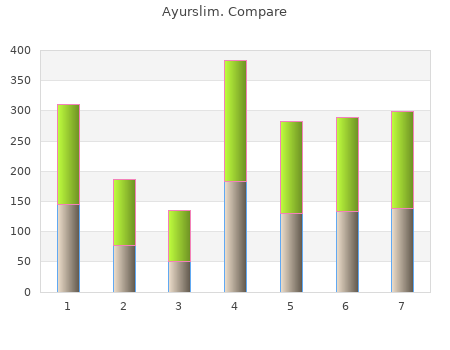By H. Gnar. Middlebury College. 2017.
As the flexion angle increased purchase 60caps ayurslim with mastercard, this tension decreased while tension in the anterior fibers increased and became dominant buy discount ayurslim 60caps online. The maximum forces in the anterior and deep fibers occurred between 40 and 50° of knee flexion, while the maximum force in the oblique fibers occurred at approximately 5° of knee flexion. The results show that the patterns of change in the ligamentous forces were not generally affected by changing the characteristics of the applied pulsing loads. However, increasing pulse amplitude (and/or duration) slightly affected the magnitude of the forces in the different ligamentous fibers. The procedure is then repeated at different positions to cover a range of knee motions. However, these quasi-static models cannot predict the velocity or acceleration of the different segments forming the joint. Also, these models are further limited in that they cannot determine the effects of the dynamic inertial loads (which occur in many daily living activities) on joint kinematics and joint loads. In this chapter, a © 2001 by CRC Press LLC FIGURE 1. The system of equations forming an anatomical quasi-static knee model is a system of nonlinear algebraic equations. These equations are solved iteratively using a Newton-Raphson iteration tech- nique,20-23,129,130 discretized and solved using the finite element method9 or rewritten as a potential energy function that can be minimized using an optimization method such as the steepest descent optimization technique. Solving a DAE system is more difficult than solving an algebraic system. Several techniques have been proposed to solve the DAE system that describes the two-dimensional dynamic response of the knee joint. Using the Differential/Algebraic System Solver software (DASSL) developed at the Lawrence Livermore National Laboratory, the latter and more complex DAE system was solved, thus describing the three-dimensional dynamic response of the knee joint.

Inter- connections between the host responses to the biomaterial and transplanted cells are stated to determine the biocompatibility of the implant [141] 60caps ayurslim with mastercard. Glass ionomers improved the mechanical properties and biocompatibility of ceramics used in the medical field purchase ayurslim 60 caps without prescription. These special types of ceramics were also presented to enhance osteogenic activity compared to HA ceramics alone [142]. It was found that even small amounts of glass ionomer can effectively bind apatite particles (unpublished data) (Fig. Glassceramics lead Hard Tissue–Biomaterial Interactions 17 Figure 13 Cortical and periosteal adaptation of rabbit bone to porous HA implant. Rods are apatite and hexagonal constituents are glass particles. There was a direct bond between osteoblast cells and mineralized layers established on the surface of the glass ceramics [145]. Glass iono- mers, on the other hand, may have adverse effects on neural tissue [146]. These implants should therefore be used with caution when implanted nearby neural tissues as in spinal surgery. Another study with peritoneal macrophages, monocytes, and bioactive glasses revealed that these bioma- terials had a moderate toxic effect on these cells [147]. Bioglass particles led to an increased release of TNF- and expression of TNF- mRNA. In vivo, induced rapid bone growth appeared to activate an autocrinelike process [147]. Ceramics, in general, are publicized as bioactive materials (Fig.

Abdominal muscle weakness: A demonstrates ef- fect of abdominal muscle weak- ness in a patient with CSF certi- fied borreliosis purchase ayurslim 60caps on-line. His first symp- tom was a feeling of distension of his abdomen order ayurslim 60 caps mastercard. The MRT scan B demonstrates the highly atro- phic ventral abdominal mus- cles. C and D shows the charac- teristic Beevor’s sign in another patient with abdominal wall in- volvement of Borreliosis Fig. Herpes zoster: A classi- cal herpes with paraspinal-tho- racal vesicular lesions and radicular distribution (T8). C Sacral herpes zoster 127 There are twelve pairs of truncal nerves, which innervate all the muscles and Anatomy skin of the trunk. The dorsal rami separate immediately after the spinal nerves exit from the nerve root foramina. They pass through the paraspinal muscles, then divide into medial and lateral branches. T1 ventral ramus consists of a large branch that joins the C8 ventral ramus to form the lower trunk of the brachial plexus, and a smaller branch that becomes the first intercostal nerve. T2–T6 are intercostal nerves that pass around the chest wall in the intercostal spaces. Half-way around they give off branches to supply the lateral chest. They end by piercing the intercostal muscles near the sternum to form the medial anterior cutaneous nerve of the thorax. The T2 ventral ramus is unique in size and distribution, and called the intercostobrachial nerve. It supplies the skin of the medial wall and the abdom- inal floor of the axilla, then crosses to the upper arm and runs together with the posterior and medial nerves of the arm (branches of the radial medial cord). The second and third intercostobrachial nerves arise from the lateral cutane- ous branches of the third and fourth intercostal nerves.

Consolidation of craniotomy lines after resorbable polylactide and titanium plating: a comparative experimental study in sheep buy discount ayurslim 60 caps on line. Effects of resorbable fixation on craniofacial skeletal growth: a pilot experi- mental study 60 caps ayurslim mastercard. Carlsson Institute for Surgical Sciences, Sahlgrens University Hospital, and University of Gothenburg, Gothenburg, Sweden Warren Macdonald, C. Magnus Jacobsson, and Tomas Albrektsson Sahlgrens University Hospital and University of Gothenburg Gothenburg, Sweden I. INTRODUCTION Total joint replacement has been claimed as ‘‘the most successful surgical procedure ever. Even in an autopsy study of implants functioning success- fully until death, Charnley found a fine fibrous membrane between the cement and cancellous bone in five out of six specimens. Clinically, aseptic loosening is characterized by pain, restricted joint function, and loss of bone stock. Radiographically, aseptic loosening presents the features of radiolucent zones at the implant–bone interface and progressive loss of bone (Fig. A precursor to clinical loosening is migration of the implant, which is only accurately detectable with roentgen stereo- metric analysis, but thereby provides a further definition of loosening [5–9]. Charnley further described a ‘‘destructive endosteal lesion’’ of the femur around a ce- mented implant, which he postulated was due to a chronic nonsuppurative infection. But removal of aseptically loosened arthroplasty components also revealed an implant bed lined by fibrous tissue which was observed as a radiolucent gap or line on radiographs [12,13]. Progression and widening of the gap was found to be correlated with failure by loosening and was attributed by some to movement of the implant [15,16], but was more commonly ascribed to ‘‘cement disease,’’ a physiological reaction to cement as a material. Acrylic cement is designated ‘‘cold-curing’’ because it cures or sets without the addition of heat, but the exothermic polymerization reaction can raise the bone interface temperatures to 70 C or higher, at which thermal necrosis of bone might occur [15,18–21]. Alternatively, leakage of the cytotoxic monomer into the adjacent tissues has been postulated as the cause of necrosis [22–25]. Or the elevated temperature might increase the toxicity of the monomer to cause chemical injury to the bone. But in fact vital microscopic studies have shown that acrylic cement has an immediate necrotic effect on the bone and some influence on the intramed- ullary circulation, and that regeneration of bone tissue is also seriously impaired [27–29].




